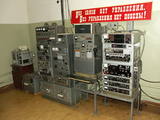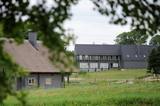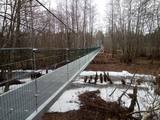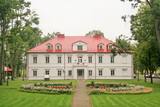| Nr | Nosaukums | Apraksts |
|---|---|---|
|
Atrodas Rojas dienviddaļā, Tukuma – Kolkas (P 131) ceļa malā, viesu nama „Zītari” pirmajā stāvā, ap 0,3 km attālumā no jūras. Piedāvā ēdināšanu, organizē dažādus pasākumus, pludmales ballītes. |
||
|
Saimniecībā "Ozoliņi" ražo ekoloģiskas tējas. Zīmols "Lauku tējas" jau vairāk kā 17 gadus ir pieejams veikalu plauktos. Saimniece turpina senču zināšanu pielietojumu mūsdienās, vācot tējas un gatavojot tās pēc senām metodēm, izmantojot fermentāciju - sutināšanu. Piedāvā izzinošas ekskursijas dabā un tēju iegādi. Labprāt dalās ar gadu gaitā iegūtām zināšanām, vadot seminārus un organizējot tēju darbnīcas. |
||
|
Rečinas vecticībnieku kopienas lūgšanu nams celts 1912. gadā. Taisnstūrveida vienas halles ēka
ar laukakmeņu mūra pamatiem un mazu cekulveida tornīti virs altāra gala. Galvenā ieeja sānu fasādē.
|
||
|
Zaļmuiža ievērojama ar savu leģendāro pagātni. 19. gs. sākumā te par rakstvedi strādāja viens no
ievērojamākajiem Latgales Atmodas celmlaužiem, dzejnieks, zemnieku tiesību aizstāvis Pīters Miglinīks
(1850 – 1883). 1784. gadā tā piederēja Fridriham fon Korfam, tad 1795. gadā Zaļmuižu par 65 000 dālderu nopirka
Krievijas cara armijas virsnieks Nikolajs Paulins fon Rozenšilds, kura mazdēls bija Krievijas Senāta civilpadomnieks.
Muižai bija plaša saimniecība, 800 ha zemes, vairākas lopu kūtis, augļu un vīna pagrabi, spirta
brūzis. No senās Zaļmuižas godības saglabājusies pārbūvēta muižas kungu dzīvojamā ēka, kā arī zemē
pusiegrimusi klētiņa. Līdz 20. gs. 60. gadiem kungu mājā atradās kolhoza „Liesma” centrs, vēlāk klubs. Tagad
te savu smēdi iekārtojis mākslinieks, metālkalējs Jānis Ļubka. Tūristi šeit var vērot metālkalšanas procesu, kā
arī paši izmēģināt pacilāt smago āmuru.
|
||
|
Šis īpaši slepenais bunkurs ar segvārdu "Pansionāts" bija viena no stratēģiski svarīgākajām vietām Padomju Latvijā kodolkara situācijas gadījumā. Rehabilitācijas centra "Līgatne" teritorijā 9m dziļumā zem zemes atrodas labiekārtots bunkurs, no kura kara gadījumā tiktu vadīta valsts, kur uzturētos tās galvenās civilās un militārās personas, kas palīdzētu izdzīvot republikai kodolkara apstākļos. Bunkuram slepenības zīmogu noņēma tikai 2003. gadā, kamdēļ līdz mūsdienām ir saglabājies viss autentiskais pazemes aprīkojums. Bunkuru var apskatīt zinoša gida pavadībā, kā arī paēst tipiskas padomju laika pusdienas. Šāda tipa objekts tik labā stāvoklī ir vienīgais Baltijas valstīs, iespējams - arī vienīgais visā padomju bloka valstīs.
|
||
|
„Limbažu sieram” ir vairāk nekā 90 gadus ilga pieredze piena pārstrādes jomā. Siera ražošanas procesā tiek izmantots tikai vietējais piens – no Vidzemes zemniekiem, bet tehnoloģiskās iekārtas ir atvestas no Šveices. 95 % no saražotās produkcijas tiek eksportēta uz ārzemēm. Blakus uzņēmumam iepretim Limbažu pilsdrupām ir veikaliņš, kurā var iegādāties produkciju. |
||
|
Lauku viensēta ar 8,9 ha lielu teritoriju atrodas Alītas rajonā, netālu no Simnas pilsētas pie gleznaina Atesio ezera Atesninki ciemā.100 m attālumā no ūdens ierīkots viesu nams ar 70 gultas vietām. Piemērota svinību un konferenču rīkošanai līdz 100 personām. Iespēja pašiem gatavot ēst, jo aprīkota ar plašu virtuvi. Lauku sēta radīta gan aktīvai, gan mierīgai atpūtai. Ir basketbola un volejbola laukumi, bērnu rotaļu laukums, dārzs, zvejas būdas, grilla vieta. Bezmaksas izmantojami 4 ūdens velosipēdi, kanoe vai koka laivas. Pirts patīkamai laika pavadīšanai. |
||
|
Šis maršruts iekļauj dažas no visautentiskajām pieredzēm, ko var iegūt ceļojot cauri zilo ezeru apgabaliem gar Latvijas un Lietuvas austrumu pusi. Šis ir reģions, kur nav redzamas tūristu masas, un cilvēki šeit ir labsirdīgi un viesmīlīgi, šeit ir tradicionāli ciemi, daudz reliģisko objektu, kā arī lauku mantojuma saimniecības. |
||
|
The tour starts at Jaunmokas Castle estate, where you will also find the Forest Museum. The pride of the castle is its unique painted tile stove (beginning of the 20th century) made of 130 painted tiles featuring 50 different views of the cities Rīga and Jūrmala. The Forest Trails runs along smaller tracks through the Austrumkursa Uplands, the valley of the river Slocene, along Lake Sekļa and Lake Jumprava to finally reach the town of Tukums. Well, the town takes pride in its pots, planters and flower beds with blooming roses along its streets. Next, the route meanders through forests to the demanding hillock of Milzkalns and Lake Valguma, where you will find the barefoot trail and a secluded art space within the woods. The Forest Trail continues to make a stopover at the Ķemeri National Park. The park is dedicated to protection of wetlands, since it is home to one of the largest marshlands of Latvia – the Great Ķemeri bog. As to the town – Ķemeri – it is the former balneological and sulphur springs resort. The tour ends in the village of Bigauņciems, where the Forest Trail joins with the Baltic Coastal Hiking Route (E9 European long distance path). Optionally, one can take a detour along the Lake Sloka trail with its bird-watching tower or pay a visit to the “Forest House” – the visitor’s centre of the Ķemeri National Park. |
||
|
Atrodas nepilnu kilometru no Aizkraukles pilskalna un redzama no Rīgas – Daugavpils šosejas (A 6). Dievnams celts (1688. g.) stāvā Daugavas ielejas krasta malā, gar kuru vēl izsekojams vecais Daugavpils ceļš. Laikā no 1896. -1899. g. baznīcu pārbūvēja neogotikas formās. No interjera pieminēt vērta ir A. Annusa altārglezna “Kungs, palīdzi mums, mēs grimstam”. Baznīcā uzstādītas memoriālās plāksnes šejienes novadniekiem - pulkvedim Jorģim Zemitānam un arhibīskapam Arnoldam Lūsim. Kāds nostāsts vēsta, ka 2. pasaules kara laikā baznīcas torni aizķērusi vācu armijas lidmašīna un tas kļuvis šķībs. |
||
|
Maltas (Borovajas) vecticībnieku kopienas lūgšanu nams ir vietējās
nozīmes arhitektūras piemineklis. Dievnama celtniecība sākta 1931. gadā, un
to cēlis būvuzņēmējs A. Gruncevičs.
|
||
|
Dzirnavu restorāns Saaremaa ir sāremiešu iecienīto garšu restorāns, kur piedāvā visu to labāko un svaigāko. Ēdienkartē atrodama medījumu gaļa no Saaremaa mežiem, vasarā arī kūpinātas zivis, našķi no ogām, vietējo ābolu vīns, kā arī labākie Saaremaa salas vīni. |
||
|
2020. gadā atjaunots gājēju tilts pāri Irbes upei, tādējādi nodrošinot ērtāku velosipēdistu un kājāmgājēju pārvietošanos pa kādreizējā Mazbānīša stigu ciemu joslā starp jūru un asfaltēto šoseju. |
||
|
Līvānu dienviddaļā, kur Zemgales iela „atduras” pret Daugavu, ir apskatāms un joprojām izmēģināms 21. gadsimtam diezgan neparasts un eksotisks transporta līdzeklis – viena no trīs Latvijas upju pārceltuvēm. Atšķirībā no Līgatnes pārceltuves, šo darbina motora, nevis pašas upes straumes spēks. Tas tiek īstenots ar troses palīdzību, kas pārvilkta pāri Daugavai. Pārceltuve ir veidota no Padomju armijas pontoniem, kas bija domāti tanku pontontiltu celšanai. Pārceltuvi izveidojuši tās īpašnieki. |
||
|
Sāremā salas augstākā (līdz 21 m), iespaidīgākā un ainaviskākā klinšu siena, kas stiepjas ~ 3 km garumā. Stipra R, ZR vēja laikā tās nelielu posmu apskalo jūras viļņi. Atsegumu veido Silūra perioda kaļķakmeņi, merģeļi un dolomīti, tādēļ to piekājē izskalots bagātīgs fosiliju klāsts – koraļļi, galvkāji, stromatopori u.c.
|
||
|
Braucot cauri Kaives ciemam, var pievērst uzmanību Kaives muižas „atliekām”. Vietas vēsture ir sena, jo jau 1440. gadā Livonijas ordeņa mestrs piešķīra šeit īpašumu Johanam Kaivenam. Kungu māja gāja bojā 1905. gadā, bet pārvaldnieka ēku nopostīja 2. pasaules kara laikā. 1956. g. nodega kalte, bet pirms trijām desmitgadēm - muižas krogs. Līdz mūsdienām palikusi tikai 1861. gadā celtā magazīna (sarkana ķieģeļu ēka) pakalnā un tai blakus esošais parks, kurā izveidots neliels skulptūru dārzs, estrāde un atpūtas vieta. |
||
|
Skaista sena parka apjoztā, nesen rekonstruētā, 19.gs. vidu atgādinošā muiža atrodas ziemeļu Lietuvā, 14 km no Paņevežiem. Bistrampolio muižas saimniecība izveidota 19.gs. otrajā pusē – 20.gs. uzbūvētas ēkas: klasicisma stila divstāvu muiža (19.gs. vidus), zirgu staļļi, pagrabi, dārznieku nams, saimniecības ēkas. Muižas saimniecību grezno 19.gs. otrajā pusē iekoptais jauktā tipa parks ar dīķiem. Muižas parkā uz Birtues kalna gozēja ievērojama lapene, blakus dārznieka namiņš. Parka siluetu atdzīvina no jauna bruģētās taciņas un dīķus savienojošie tiltiņi. |
||
|
Vieta, ko nekādi nevar uzskatīt par tūrisma objektu, bet tajā pat laikā tas ir Latvijas mērogā nozīmīgs kultūras un vēstures piemineklis, ko nevar nepieminēt! Laikā no 1923. – 1943. gadam muižas pilī atradās Latvijā zināmākā mājturības skola, kurā mācījās izslavētās kaucmindietes! Tagad muižas pils ir pamesta, avārijas stāvoklī un apskatāma tikai no ārpuses un „pa gabalu”. Ap 1780. gadu celtā pils, kas 1909. – 1912. g. tika pārbūvēta pusloka būvapjomā, ir Latvijai diezgan unikāls arhitektūras paraugs. |
||
|
Atrodas Vecpiebalgas dienvidaustrumdaļā aiz baznīcas. 1340. - 1365. g. Rīgas arhibīskaps šeit uzcēla pili - cietoksni, ko apjoza aizsarggrāvji (atliekas redzamas arī mūsdienās). Pils ziemeļu pusē atradās priekštilta nocietinājumi, bet austrumdaļā - pils galvenā ieeja un tornis. Pili postīja 1577. g., bet pilnībā sagrāva 18. gs. |
||
|
Otra vieta Kuršu kāpu Lietuvai piederošajā teritorijā, kur var iepazīt „tuksneša ainavu". 52 m augstās Pārnidas kāpas apskati var sākt ar Saules laikrādi (celts 1995. g., godinot Lietuvas neatkarības atgūšanas dienas piecgadi), no kura paveras Baltijas valstīm neparasta ainava līdz pat Lietuvas – Krievijas robežai. Te joprojām ir redzamas ceļojošās kāpas, kas radās 18. gs., cilvēkiem izcērtot mežus! Interesanti (īpaši vakaros!) ir arī skati uz Nidas pilsētiņu un Nidas ostu. Kuršu jomas pusē ir izveidota marķēta dabas izziņas taka, kas ved (sekojiet līdzi marķējumam!) arī pa kāpas smiltājiem. Šīs vietas apskatei ir jārēķinās ar ~ 1h. Uzmanību! Novirzīties no takas un pārvietoties pa kāpu smiltājiem nav atļauts! |
||





















